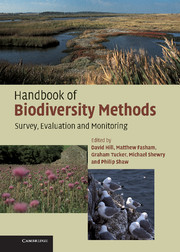Book contents
- Frontmatter
- Contents
- Preface
- Acknowledgements
- Part I Planning
- 1 Introduction to planning
- 2 Planning a programme
- 3 Biodiversity evaluation methods
- Part II Habitats
- Part III Species
- Appendix 1 Monitoring and reporting obligations under international conservation agreements
- Appendix 2 Relationship between BAP Priority Habitat and Broad Habitat categories and Habitats Directive nomenclature
- Appendix 3 Annotated list of key references for plant identification
- Appendix 4 Determining appropriate quadrat size for vegetation sampling
- Appendix 5 The relocation of permanent plots
- Appendix 6 Equipment required for undertaking different types of survey
- Recommended sources of further information
- References
- Glossary
- Index
3 - Biodiversity evaluation methods
Published online by Cambridge University Press: 01 September 2010
- Frontmatter
- Contents
- Preface
- Acknowledgements
- Part I Planning
- 1 Introduction to planning
- 2 Planning a programme
- 3 Biodiversity evaluation methods
- Part II Habitats
- Part III Species
- Appendix 1 Monitoring and reporting obligations under international conservation agreements
- Appendix 2 Relationship between BAP Priority Habitat and Broad Habitat categories and Habitats Directive nomenclature
- Appendix 3 Annotated list of key references for plant identification
- Appendix 4 Determining appropriate quadrat size for vegetation sampling
- Appendix 5 The relocation of permanent plots
- Appendix 6 Equipment required for undertaking different types of survey
- Recommended sources of further information
- References
- Glossary
- Index
Summary
BIODIVERSITY VALUES AND EVALUATION PURPOSES
In general terms, biodiversity evaluation is the process of measuring the value (ideally quantitatively) of biodiversity components, such as the number of species present, the population of a species, a habitat (usually meaning a vegetation community) or the sum of all such components within a given area or site. Such evaluations may be carried out for a variety of reasons, e.g. for conservation priority setting, as part of Biodiversity Action Plan (BAP) development, for the selection of Protected Areas, for the identification of a site's features of conservation interest, as part of conservation objective setting, management planning and monitoring processes, and as part of an EIA or other statement to comply with planning procedures for a proposed development.
Evaluations may be carried out on various components of biodiversity (i.e. from genetic variation within species, to individual species, species assemblages, biotopes and biomes) and at a variety of scales, from specific sites, to counties, regions, countries, biogeographical areas (although these may be smaller than countries) and global. A wide range of potential biodiversity values may be considered, including intrinsic and socio-cultural values (Daily, 1997; Posey, 2000), and more direct socio-economic benefits (Daily, 1997), such as food, building resources, medicines and waste decomposition, etc. (Spellerberg & Hardes, 1992).
As this Handbook concentrates on site surveys and monitoring, rather than on regional- or national-scale studies, this chapter focuses on site evaluations.
Information
- Type
- Chapter
- Information
- Handbook of Biodiversity MethodsSurvey, Evaluation and Monitoring, pp. 65 - 102Publisher: Cambridge University PressPrint publication year: 2005
Accessibility standard: Unknown
Why this information is here
This section outlines the accessibility features of this content - including support for screen readers, full keyboard navigation and high-contrast display options. This may not be relevant for you.Accessibility Information
- 1
- Cited by
